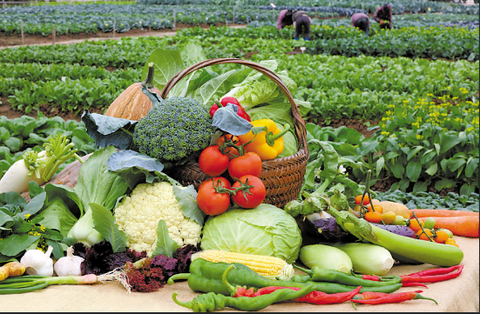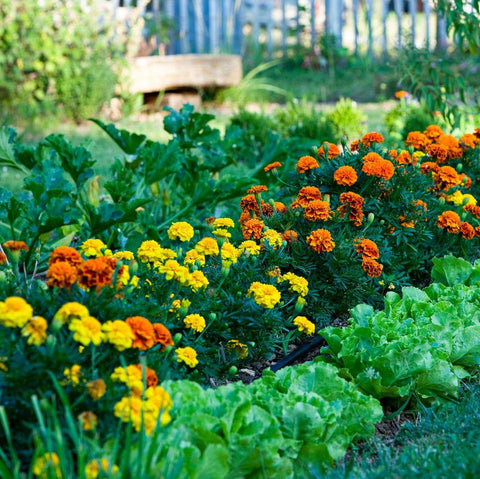As the vibrant greens of summer begin to mellow into the warm hues of autumn, it's the perfect time to transform your garden into a symphony of fall colors. A well-planned and color-coordinated fall garden can be a breathtaking sight, creating a sense of visual harmony that soothes the soul and celebrates the changing seasons. In this comprehensive guide, we'll explore the art of crafting a color-coordinated fall garden, from selecting the right plants to arranging them in a way that mesmerizes the eye. The following content also has some reference value for raised garden beds.

The Magic of a Color-Coordinated Fall Garden
Fall is a season of transition, where nature puts on a dazzling display of colors before the winter slumber. By curating a color-coordinated fall garden, you can capture this magic in your own outdoor space. Here's why it's worth the effort:
- Aesthetic Pleasure: A well-designed fall garden pleases the senses and offers an inviting space for relaxation and contemplation.
- Cohesiveness: Color coordination brings a sense of order and unity to your garden, creating a cohesive and visually appealing landscape.
- Seasonal Celebration: Celebrating the colors of fall in your garden allows you to connect with the changing seasons and appreciate the beauty of nature's cycle.
- Stunning Backdrop: A color-coordinated garden provides a stunning backdrop for outdoor gatherings, photos, and family events.
Planning Your Color-Coordinated Fall Garden
Creating a harmonious fall garden is an art that involves thoughtful planning and careful plant selection. Here's how to get started:
1. Choose Your Color Palette
Begin by selecting a color palette that resonates with the fall season. Traditional fall colors include warm tones like red, orange, yellow, and deep shades of purple and burgundy. You can also incorporate neutral hues like brown and gold to add depth and balance.
2. Consider Foliage Colors
While flowers play a significant role in fall gardens, don't forget about foliage. Many trees and shrubs showcase brilliant leaf colors in the fall, such as maples, oaks, and sweetgums. Incorporating these plants can add a dynamic dimension to your garden.
3. Plant Selection
Choose plants that bloom or display vibrant foliage during the fall season and align with your chosen color palette. Here are some excellent options for a color-coordinated fall garden:
- Reds and Oranges:
- Chrysanthemums (Mums): These classic fall flowers come in a range of warm colors and provide a burst of color in your garden.
- Japanese Maples: Some varieties of Japanese maples display fiery red and orange foliage in the fall.
- Helenium (Sneezeweed): With its daisy-like flowers in shades of red and orange, helenium adds a touch of autumn warmth.
- Yellows and Golds:
- Black-Eyed Susans: These cheerful, yellow flowers bloom profusely in the late summer and early fall.
- Goldenrod: Known for its bright yellow plumes, goldenrod is a favorite among pollinators.
- Coreopsis: With daisy-like flowers in various shades of yellow, coreopsis adds a sunny disposition to your garden.
- Purples and Burgundies:
- Asters: Asters come in various shades of purple and lavender, providing a beautiful contrast to warmer colors.
- Sedum (Stonecrop): Some sedum varieties turn deep burgundy in the fall, creating a stunning visual effect.
- Beautyberry (Callicarpa): This shrub produces vibrant purple berries that persist into the fall.
4. Planting Layout
When arranging your plants, consider their height, shape, and growth habit. Place taller plants towards the back or center of your garden and shorter ones towards the front. This creates depth and ensures that each plant has its moment in the spotlight.

5. Seasonal Overlaps
To maintain a color-coordinated garden throughout the fall season, choose plants with staggered bloom times. This ensures that as one set of flowers fades, another bursts into color, providing a continuous display.
6. Care and Maintenance
Regularly deadhead spent flowers to encourage new blooms and remove faded foliage to keep your garden looking fresh. Water your plants as needed, especially during dry spells, to keep them healthy and vibrant.
Design Ideas for a Color-Coordinated Fall Garden
Now that you've laid the groundwork for your color-coordinated fall garden, let's explore some design ideas to make your garden truly captivating:
1. Monochromatic Garden:
Create a sense of serenity and simplicity by focusing on a single color. For example, a garden filled with various shades of red can evoke warmth and passion.
2. Warm vs. Cool Contrasts:
Play with the contrast between warm and cool colors. Plant warm-toned flowers like reds and oranges alongside cool-toned plants like purples and blues to create a visually striking garden.
3. Layered Borders:
Design your garden with layered borders, placing taller plants at the back and gradually decreasing in height towards the front. This creates a sense of depth and allows each layer to showcase a different color.
4. Seasonal Transition:
Plan your garden to transition from late summer to early fall to late fall. Start with late-summer bloomers like black-eyed Susans, followed by fall bloomers like mums and asters, and finish with late-fall foliage plants like Japanese maples.
5. Foliage Focus:
Incorporate trees and shrubs with stunning fall foliage as anchor points in your garden. These plants provide structure and serve as a backdrop for seasonal flowers.
Additional Tips for a Stunning Fall Garden
To ensure your color-coordinated fall garden reaches its full potential, consider these additional tips:
1. Mulch and Edging:
Apply a layer of mulch to your garden beds to conserve moisture and create a tidy appearance. Use edging materials like stones or bricks to define the borders and add a polished look.
2. Container Gardens:
Don't limit your fall garden to just the ground. Create container gardens with fall-blooming flowers and ornamental grasses to add height and variety to your landscape.
3. Lighting Effects:
Install outdoor lighting to showcase your garden's beauty during the evening hours. Well-placed lights can accentuate the colors and create a magical atmosphere.
4. Wildlife-Friendly:
Choose plants that attract pollinators like bees and butterflies, as well as birds that may visit your garden for food and shelter.
5. Fall Decorations:
Enhance the fall ambiance with seasonal decorations like pumpkins, gourds, and ornamental corn. These can complement your color-coordinated garden and add a touch of festivity.

Conclusion
Creating a color-coordinated fall garden is a labor of love that rewards you with a visual masterpiece and a deep connection to the changing seasons. Whether you opt for warm, monochromatic hues or contrasting colors that pop, the key is to plan carefully, choose the right plants, and maintain your garden with care. As the leaves fall and temperatures drop, your garden will stand as a testament to the beauty of nature's transition and the artistry of your green thumb. So, go ahead, paint your outdoor canvas with the colors of fall, and savor the beauty of this enchanting season.









